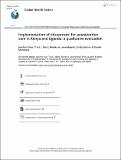| dc.contributor.author | Osur, Joachim | |
| dc.contributor.author | Baird, Traci L. | |
| dc.contributor.author | Levandowski, Brooke A. | |
| dc.contributor.author | Jackson, Emily | |
| dc.contributor.author | Murokora, Daniel | |
| dc.date.accessioned | 2022-03-26T12:53:36Z | |
| dc.date.available | 2022-03-26T12:53:36Z | |
| dc.date.issued | 2013-04-24 | |
| dc.identifier.citation | Osur J, Baird TL, Levandowski BA, Jackson E, Murokora D. Implementation of misoprostol for postabortion care in Kenya and Uganda: a qualitative evaluation. Glob Health Action. 2013 Apr 24;6:1-11. doi: 10.3402/gha.v6i0.19649. PMID: 23618341; PMCID: PMC3636418. | en_US |
| dc.identifier.other | PMID: 23618341 | |
| dc.identifier.other | PMCID: PMC3636418 | |
| dc.identifier.other | DOI: 10.3402/gha.v6i0.19649 | |
| dc.identifier.uri | https://repository.amref.ac.ke/handle/123456789/635 | |
| dc.description | Glob Health Action 2013. @ 2013 Joachim Osur et al. This is an Open Access article distributed under the terms of the Creative Commons Attribution-
Noncommercial 3.0 Unported License (http://creativecommons.org/licenses/by-nc/3.0/), permitting all non-commercial use, distribution, and reproduction
in any medium, provided the original work is properly cited. | en_US |
| dc.description.abstract | Objective: Evaluate implementation of misoprostol for postabortion care (MPAC) in two African countries.
Design: Qualitative, program evaluation.
Setting: Twenty-five public and private health facilities in Rift Valley Province, Kenya, and Kampala
Province, Uganda.
Sample: Forty-five MPAC providers, health facility managers, Ministry of Health officials, and nongovernmental
(NGO) staff involved in program implementation.
Methods and main outcome measures: In both countries, the Ministry of Health, local health centers and
hospitals, and NGO staff developed evidence-based service delivery protocols to introduce MPAC in selected
facilities; implementation extended from January 2009 to October 2010. Semi-structured, in-depth interviews
evaluated the implementation process, identified supportive and inhibitive policies for implementation,
elicited lessons learned during the process, and assessed provider satisfaction and providers’ impressions of
client satisfaction with MPAC. Project reports were also reviewed.
Results: In both countries, MPAC was easy to use, and freed up provider time and health facility resources
traditionally necessary for provision of PAC with uterine aspiration. On-going support of providers following
training ensured high quality of care. Providers perceived that many women preferred MPAC, as they avoided
instrumentation of the uterus, hospital admission, cost, and stigma associated with abortion. Appropriate
registration of misoprostol for use in the pilot, and maintaining supplies of misoprostol, were significant
challenges to service provision. Support from the Ministry of Health was necessary for successful
implementation; lack of country-based standards and guidelines for MPAC created challenges.
Conclusions: MPAC is simple, cost-effective and can be readily implemented in settings with high rates of
abortion-related mortality. | en_US |
| dc.description.sponsorship | Swedish International
Development Cooperation Agency (Sida), UKAid, and
other Ipas donors | en_US |
| dc.language.iso | en | en_US |
| dc.publisher | COACTION Publishing | en_US |
| dc.subject | Misoprostol | en_US |
| dc.subject | Postabortion care | en_US |
| dc.subject | Implementation research | en_US |
| dc.title | Implementation of Misoprostol for Post-abortion Care in Kenya and Uganda: A Qualitative Evaluation | en_US |
| dc.type | Article, Journal | en_US |

